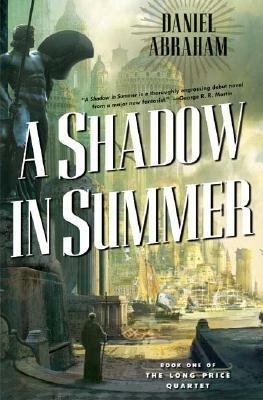One of my greatest pleasures in reading is re-reading for the first time something I really enjoyed the first time and finding it even better without the rush to find out what happens.
A Shadow in Summer is the first book of Daniel Abraham’s Long Price Quartet, that most unusual of new fantasy series, complete in four volumes. I loved these books when I first read them, and I love them even more now that I’m re-reading them. They have an original world, a fascinating magic system, great characters and good volume completion within a strong overall plot arc. I urge them to your attention. You should start with A Shadow in Summer and read them in order, because while I’m fairly sure the later ones would stand alone well, they do inevitably contain spoilers for the earlier ones. I’m going to be looking at all four of them individually.
The Long Price Quartet is a set of four novels, not one book split into four. There are fifteen years between each of the volumes, and the main characters begin at about fifteen and end at about sixty. A Shadow in Summer introduces the world and the characters. It’s set not only in summertime but (almost entirely) in Saraykeht, one of the Summer Cities of the Khaiem. The Cities of the Khaiem used to be an Empire, a long time ago, but the Empire destroyed itself. What’s left is a set of city states kept in balance by the Dai-kvo, who controls the poets who control the andat, concepts given physical form and volition. Away from the cities, the rest of the world looks towards them greedily, but the powers of the andat are strong enough to keep them away. A Khai rules each city, producing three sons who traditionally kill each other, leaving the strongest to inherit his father’s place. Younger sons undertake the training to become poets. Most fail.
The two main characters of the series, Otah and Maati, are both younger sons who succeed in the poet’s training. Otah walks away from it to live in disguise. Maati gets sent to Saraykeht to train with that city’s poet and andat, Heshai and Seedless. Seedless meanwhile is deep in plots with the city’s enemies, intended to harm Heshai and win his own freedom.
A Shadow in Summer is largely concerned with the boys and the andat and the plots and the exploration of the world. But it is also the tragedy of Amat, an old woman who has made her way through the ranks of a trading house until she’s wealthy and powerful. Her life is disrupted by the conspiracy, and she becomes set on exposing everyone involved. She’s an unlikely hero for a fantasy novel, a commoner, an old woman with a bad leg, an accountant. She doesn’t go on any great journeys, indeed she hardly goes more than a mile from home. But while the pattern of the series belongs to Otah and Maati, this book is Amat’s. And that’s just so cool and unusual it delights me.
I mentioned above that the book is a tragedy—I meant in the Aristotelean sense in that people act by being themselves for their best reasons and bring about their downfall and their society’s downfall. It’s not a downbeat book. But there’s a sense of inevitability that runs through it. This is a very well-built world, and part of that is that the things that are wrong with it, the things that will inevitably destroy it and bring it to a new vision of itself, are present right from the beginning.










